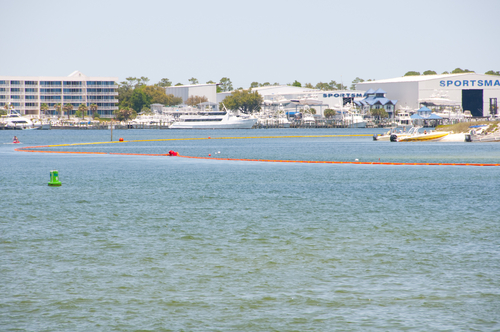 |
SPCC Secondary Containment FAQs
Q: What are the differences between general and specific secondary containment requirements in the SPCC rule?
A: The general requirements address the potential for oil discharges from all regulated parts of a facility. Using good engineering practices, the containment method, design, and capacity should be determined to contain the most likely discharge of oil until cleanup occurs.
The specific requirements address the potential of a major container failure and subsequent oil discharge from areas of a facility where oil is stored or handled. The containment design, sizing, and freeboard requirements are specified by the SPCC rule to address a major container failure.
Q: Does the Environmental Protection Agency (EPA) define exactly what types of secondary containment must be used?
A: The EPA lists secondary containment options in 40 CFR 112.7(c) for both onshore and offshore facilities and states “At a minimum, you must use one of the … prevention systems or its equivalent.” However, EPA’s Guidance for Regional Inspectors also notes that “These methods are examples only; other containment methods may be used, consistent with good engineering practice.” Thus, it is up to the facility owner/operator to determine whether they meet the “good engineering practice” requirement through self-certification or certification by a licensed professional engineer (PE).
Simplify SPCC compliance with the NEW TRAC360 platform. In just a few minutes, see how easy it is to create compliant plans and checklists, train your team, and find answers to all your SPCC questions. Learn More.
Q: Does the EPA require the calculations used to determine secondary containment be included in the SPCC Plan?
A: No, the EPA does not require that calculations be included in a facility’s SPCC Plan. However, the EPA “strongly recommends” that the calculations that were used as the basis for secondary containment capacity be maintained and available to inspectors, should questions arise. In addition, industry guidance does recommend that secondary containment capacity and/or design calculations be included in the Plan, and the American Petroleum Institute’s Bulletin D16 (Fifth Edition, April 2011) titled, “Suggested Procedure for Development of a Spill Prevention, Control, and Countermeasures Plan” provides examples of calculations that inspectors may refer to during a facility inspection.
The Ultimate SPCC Compliance Tool
TRAC360 for SPCC is a powerful application that simplifies compliance with EPA’s Spill Prevention, Control, and Countermeasure rule. Whether you need help creating your facility-specific SPCC pPlan, writing inspection checklists for your tanks, or training your oil-handling workforce, TRAC360 is there to help. Learn More.
Q: How does the EPA define “sufficient freeboard”?
A: In the SPCC rule, the EPA does not define the term “sufficient freeboard” and does not provide any specific direction about calculating freeboard volume. In the 2002 amendments to the SPCC rule, the EPA noted “We believe that the proper standard of ‘sufficient freeboard’ to contain precipitation is that amount necessary to contain precipitation from a 25-year, 24-hour storm event,” however the Agency did not set this as a requirement and as a result, it is not enforceable. As it stands now, the EPA relies on “engineering practice” to determine appropriate freeboard capacity for secondary containment, noting that when data regarding storm events are available “the facility owner/operator (and/or certifying PE) may want to consider the appropriateness of the 25-year, 24-hour storm event precipitation design criteria for containment freeboard.”
In addition, the EPA also adds that a 110-percent of storage tank capacity rule of thumb may be acceptable for designing secondary containment freeboard in many situations, and that this is a minimum requirement for aboveground storage tanks in many states. Some states, however, do require facilities to consider storm events in the design, which may result in more stringent sizing criteria.
Q: What is the difference between an active measure of secondary containment and a passive measure?
A: Active secondary containment measures require deployment or other specific actions by the owner or operator, either before an activity involving the handling of oil begins, or in reaction to a discharge, so long as the active measure is designed to prevent an oil spill from reaching navigable water or adjoining shorelines. Active measures may be used when permanent containment structures are not feasible. Passive measures are permanent installations and do not require deployment or action by the owner/operator.
